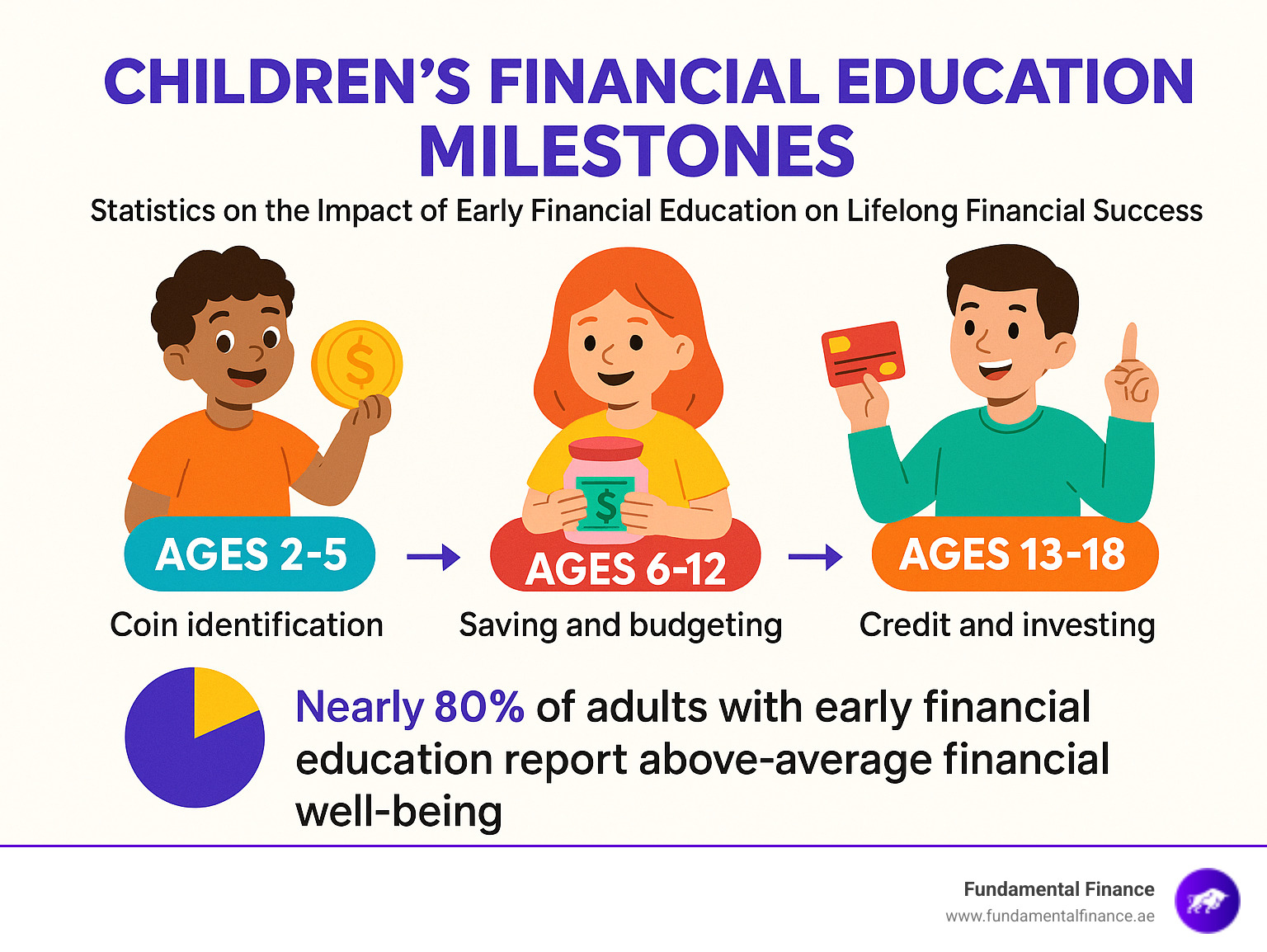Beyond Allowance: Fun Ways to Teach Children About Finance
Time to Read:
10

Why Financial Education Starts in Childhood
Teach kids finance early, and you're giving them a superpower that will serve them for life. Research shows that money habits are already formed by age seven, making childhood the perfect time to build a strong financial foundation.
Quick ways to teach kids finance:
- Ages 2-5: Use play money and pretend stores to teach basic value concepts
- Ages 6-10: Implement the three-jar system (save, spend, give) and teach needs vs. wants
- Ages 11-18: Open bank accounts, create budgets, and introduce investing basics
- All ages: Model good financial behavior and have regular money conversations
The statistics are eye-opening. In America, four in five youths failed a financial literacy quiz, and less than one in five adults feel confident about their saving habits. Even more concerning, discussing money brings anxiety to about 53 percent of adults.
But here's the good news: parents are the number one source of financial learning for their kids. Your influence is more powerful than financial literacy courses, peers, jobs, and media combined.
When you teach children about earning, saving, spending, and giving from an early age, you're not just teaching math skills. You're building confidence, independence, and decision-making abilities that will help them steer an increasingly complex financial world.
The research is clear - toddlers can learn basic concepts like value and exchange. By starting early with fun, hands-on activities, you can help your child develop the financial fluency they'll need to build wealth, avoid debt, and make smart money decisions throughout their life.

Why Teaching Kids About Money Early is a Game-Changer
Picture this: your seven-year-old confidently comparing prices at the grocery store, or your teenager making smart choices about their first job earnings. This isn't just wishful thinking – it's what happens when we teach kids finance from an early age.
Here's something that might surprise you: money habits are already formed by age seven. By the time your child loses their first tooth, their attitudes about earning, saving, and spending are already taking shape. That's why starting early isn't just helpful – it's absolutely crucial.
When we introduce financial concepts early, we're setting our children up for lifelong success. They learn to avoid the debt traps that catch so many adults off guard. More importantly, they develop the confidence to build real wealth over time. Instead of feeling anxious about money decisions, they approach them with knowledge and calm.
The ripple effects go far beyond their bank accounts. Teaching children about money helps them develop strong decision-making skills that serve them in every area of life. It's about creating a foundation for generational wealth that can benefit not just your child, but their children too.
The Surprising Benefits of Financial Fluency
When children understand money, something magical happens. They develop a confidence that shows up in unexpected places. Watch a child successfully save for something they really want – the pride on their face is unmistakable.
This confidence naturally leads to greater independence. They start making their own choices and understanding the consequences. No more endless "Can I have this?" requests at the store – they begin to think through purchases on their own.
Perhaps most valuable is learning delayed gratification. In our instant-everything world, children who can wait and save for what they want develop incredible self-control. This skill helps them in school, relationships, and eventually their careers.
Financial education also improves goal setting abilities. Whether they're saving for a new video game or planning for college, children learn to break big dreams into manageable steps. Plus, all that calculating change and figuring out interest rates gives their math skills a real-world boost.
Most importantly, understanding money helps children understand the world around them. They start to grasp how businesses work, why prices change, and how families make financial decisions together.
The Cost of Waiting: Statistics You Can't Ignore
The numbers tell a sobering story about what happens when financial education gets delayed. In America, four in five youths failed a financial literacy quiz. Even more concerning, less than one in five adults feel confident about their saving habits.
Here's a statistic that really hits home: discussing money brings anxiety to about 53 percent of adults. Imagine carrying that emotional burden every time you need to make a financial decision.
The impact on families is even more dramatic. Studies show that 70% of wealth disappears by the end of the second generation, and a staggering 90% is gone by the third generation. This means the financial security we work so hard to build for our children might not even reach our grandchildren.
But here's the encouraging part: when we teach kids finance early, we can completely change this trajectory. We're not just helping our children – we're potentially changing our entire family's financial future for generations to come.
The Core Four: Earning, Saving, Spending, and Giving
When we teach kids finance, it all comes down to four simple building blocks: earning, saving, spending, and giving. These aren't just fancy concepts to memorize - they're life skills best learned by rolling up your sleeves and diving in.
Think of it this way: you wouldn't teach someone to ride a bike by showing them pictures. The same goes for money. Kids need to touch it, count it, and make real decisions with it. That's where experiential learning works its magic.
The beauty of establishing clear routines around these four pillars is that money management becomes second nature. Just like brushing teeth or making their bed, handling money thoughtfully becomes part of who they are.
Here's where the three-jar system becomes your secret weapon. Get three clear jars and label them "Save," "Spend," and "Give." Suddenly, money isn't this abstract thing - it's something they can see growing in each jar. It's tangible, visual, and incredibly powerful for young minds.

Earning: More Than Just an Allowance
Here's where many parents miss a golden opportunity. Traditional allowances - money given just for existing - don't teach the fundamental truth about money: it comes from providing value.
Instead, try commissions for chores. Your child cleans their room thoroughly? They earn money. They help with yard work? More earnings. This isn't about being harsh - it's about connecting effort with reward, just like the real world works.
But don't stop there! Entrepreneurship can be incredibly fun for kids. Remember the classic lemonade stand? It's a mini-business school. They learn about costs (lemons, cups, sugar), pricing, customer service, and profit.
Creative projects work beautifully too. Maybe your daughter makes friendship bracelets to sell, or your son creates custom drawings for neighbors. These experiences teach the value of work in ways no lecture ever could.
The goal isn't to turn your home into a sweatshop. It's to help kids understand income as something earned, not given. This single shift in perspective can transform their relationship with money forever.
Saving: The Magic of Watching Money Grow
There's something almost magical about watching that clear savings jar fill up, coin by coin, dollar by dollar. For kids, seeing their money grow is incredibly motivating - much more so than some abstract number in an app.
The key is helping them set goals. What are they saving for? A new bike? A special toy? A family trip? Having a target makes every coin dropped into that jar feel meaningful.
This is also the perfect time to explore needs vs. wants. A winter coat? That's a need. The latest video game? That's a want. Both are valid, but understanding the difference helps kids prioritize and make smarter choices.
As their savings grow, consider opening a bank account together. In the UAE, there are several recommended ways to start a savings account for children, often linked to a parent's account for easy management. This big step introduces them to the banking system and makes saving feel more "grown-up."
Here's where you can blow their minds: introduce compound interest. Show them how money can actually make more money over time. Even simple examples work wonders. Money earning 4% interest doubles in about 18 years thanks to the Rule of 72. For a 10-year-old, that means money they save today could double by the time they graduate college!
Spending: Making Smart Choices
Spending is usually the most exciting part for kids, but it's also where the most important lessons happen. Smart spending isn't about being cheap - it's about being intentional.
Start with budgeting basics. Even young kids can learn to divide their "spend" money between immediate wants and bigger future purchases. This simple exercise builds planning skills that will serve them for life.
Opportunity cost is a fancy term for a simple idea: choosing one thing means giving up another. If they spend their money on candy today, they won't have it for movie tickets this weekend. This concept helps kids think through their choices more carefully.
Comparison shopping can actually be fun! Involve them in looking for deals, comparing prices, or finding gently used items instead of new ones. They'll learn to be smart consumers who get the most value for their money.
As kids get older, discussing cash vs. digital money becomes important. Physical cash helps younger children understand value and exchange. Digital payments, while convenient, can feel less "real" and lead to overspending.
For teenagers especially, understanding how to manage shared expenses matters. Whether it's splitting pizza with friends or figuring out everyone's share of a group gift, our guide to splitting the bill with friends can help them steer these social money situations gracefully.
Giving: Cultivating a Generous Spirit
The "Give" jar might be the most important of all. It teaches kids that money isn't just about them - it's also about making a positive impact on others.
Start by talking about charity and donating to causes they care about. Maybe they love animals and want to support a local shelter. Or perhaps they're concerned about the environment and want to contribute to conservation efforts.
For families in the UAE, discussing Zakat provides a beautiful framework for understanding giving as both a responsibility and a privilege. It's not just about helping others - it's about recognizing our interconnectedness and building empathy.
Let your children help decide where to give. This involvement creates a deeper connection to the act of generosity. Our Zakat Calculator for families can help illustrate how giving is a structured part of financial responsibility.
Community involvement through giving teaches kids they're part of something bigger than themselves. Whether they're contributing to a local food bank or helping a classmate in need, these experiences shape them into compassionate, community-minded individuals.
The beautiful thing about the giving jar is that it often becomes kids' favorite part of the whole system. There's something deeply satisfying about using your money to help others - a lesson that will enrich their entire lives.
Age-by-Age Guide to Teach Kids Finance
Every child develops at their own pace, but when it comes to financial education, there are certain developmental milestones that can guide us. Teaching kids finance effectively means meeting them where they are cognitively and emotionally. A two-year-old isn't ready for compound interest calculations, but they can absolutely understand that different coins have different values!
The beauty of age-appropriate financial education is that it builds naturally. Each stage prepares them for the next, creating a solid foundation that grows stronger over time. Think of it like learning to read – we start with letters, move to words, then sentences, and eventually complex stories.

Toddlers & Preschoolers (Ages 2-5): Playful Beginnings
Don't underestimate your little ones! Research shows that even toddlers can grasp basic financial concepts when presented through play. At this age, everything is about hands-on exploration and making abstract ideas concrete.
Coin identification becomes a fun game. "Can you find the shiny dirham?" or "Show me the smallest coin!" turns learning into an trip. Children this age love sorting activities, so separating different coins by size, color, or value keeps them engaged while building foundational knowledge.
Play stores are absolute magic at this age. Set up a pretend shop with their toys as merchandise and use play money for transactions. Watch their eyes light up as they begin to understand that different items have different "costs" and that they need to "pay" to receive something. This simple activity introduces the concept of exchange in the most natural way possible.
Delayed gratification games can start small but make a big impact. "If you wait until after lunch, you can have two cookies instead of one" teaches them that patience often leads to better rewards. These tiny moments of self-control are building blocks for future saving habits.
Counting money at this age is really about number recognition and basic math skills. Make it playful – count coins while putting them in a piggy bank, or use songs and rhymes to make the numbers stick.
How to teach kids finance in elementary school (Ages 6-10)
Elementary school age is when financial concepts really start to click. Their improved math skills and longer attention spans open up exciting opportunities to teach kids finance in more structured ways.
The three-jar system becomes your best friend during these years. "Save," "Spend," and "Give" jars make money management visual and tangible. Children can physically see their money growing in each category, which is incredibly motivating. Don't be surprised if they become obsessed with counting their savings jar!
Needs vs. wants conversations become much richer now. They can understand why groceries are necessary but candy is optional. Use real shopping trips as teaching moments – "We need milk for breakfast, but do we need that expensive cereal, or would the regular one work just as well?"
Basic budgeting starts to make sense when tied to their own desires. If they receive $10 weekly, help them decide how much goes to each jar. Maybe $4 for spending, $5 for saving toward that special toy, and $1 for giving. Let them adjust these amounts as they learn what works for them.
Setting short-term savings goals becomes exciting when they can do the math themselves. "That video game costs $30, and you're saving $5 per week, so you'll have it in six weeks!" Suddenly, math has a real purpose, and the anticipation makes the eventual purchase even sweeter.
This is also the perfect age to explore gamified financial literacy tools that make learning feel like playing. Interactive games and apps can reinforce these concepts in engaging ways that traditional teaching methods sometimes can't match.
Recommended money books for kids become valuable bedtime reading. Stories about characters learning to save, spend wisely, or start their own businesses help reinforce lessons in memorable ways. Reading together also creates opportunities for discussions about the characters' financial choices.
How to teach kids finance as teenagers (Ages 11-18)
The teenage years bring both excitement and challenges in financial education. Your teens are gaining independence and making real financial decisions, which means the stakes are higher, but so are the learning opportunities.
Opening a debit account marks a significant milestone in their financial journey. This isn't just about having their own card – it's about learning to track spending, manage a real account, and understand banking basics. Start with a linked account that allows you to monitor transactions while giving them increasing autonomy.
Budgeting for social life suddenly becomes very real and very important. Teens want to go out with friends, buy clothes, and participate in activities that cost money. This creates natural motivation to learn budgeting skills. Use our free tool to create a teen budget to help them visualize their income and expenses clearly.
Understanding credit vs. debit is crucial at this age. Explain that debit cards use their own money, while credit involves borrowing. If appropriate, consider making them an authorized user on your credit card with strict rules about repayment. This gives them supervised practice with credit before they're on their own.
Introduction to investing doesn't have to be overwhelming. Start with simple concepts like compound interest and how money can grow over time. Use concrete examples – show them how $100 invested at age 16 could become $800 by age 65 with compound growth. These numbers can be eye-opening!
Avoiding debt becomes a critical conversation, especially about high-interest consumer debt. Help them understand that credit cards aren't "free money" and that living within their means is a cornerstone of financial health. Share real examples of how debt can spiral and impact future goals.
The teenage years are when financial education transitions from lessons to life skills. Your role shifts from teacher to mentor, guiding them as they make increasingly independent financial decisions that will shape their adult relationship with money.
The Parent's Playbook: Modeling and Mentoring
As parents, we hold the most powerful position in shaping our children's financial future. We're not just providers or rule-setters – we're their first and most influential financial mentors. The way we handle money, talk about it, and demonstrate financial responsibility becomes the blueprint our children follow throughout their lives.
Research consistently shows that parental influence outweighs financial literacy courses, peer pressure, jobs, and media combined when it comes to money habits. This gives us incredible power, but also significant responsibility. When we teach kids finance, we're not just sharing information – we're modeling a way of life.

Be the Example: More is Caught Than Taught
Your children are watching everything you do with money, even when you don't realize it. They notice when you check prices at the grocery store, when you decide to wait before making a purchase, and how you react when the bill comes at a restaurant.
Budgeting openly can be one of your most powerful teaching tools. Instead of hiding your financial planning, consider doing it at the kitchen table where your children can see. Show them how you allocate money for different expenses, how you prioritize needs over wants, and how you plan for both short-term and long-term goals.
Talking about financial goals makes money management real and relatable. Whether you're saving for a family vacation, a home improvement project, or building an emergency fund, involving your children in age-appropriate discussions helps them understand that financial success requires planning and patience.
One of the most valuable lessons you can model is avoiding impulse buys. When you see something you want, verbalize your thought process: "This looks nice, but let me think about whether we really need it" or "I'm going to wait a day before deciding." This teaches them that thoughtful spending is a habit, not just a rule.
Showing contentment with what you have is especially important in our consumer-driven world. When you express gratitude for your home, your car, or even a simple meal, you're teaching them that happiness doesn't come from constantly acquiring more things.
Discussing money brings anxiety to about 53 percent of adults, but you can break this cycle by creating a calm, open environment around financial conversations in your home.
Common Mistakes Parents Make (And How to Avoid Them)
Even with the best intentions, many parents unknowingly undermine their children's financial education. Here are the most common pitfalls and how to sidestep them:
Giving allowance without responsibility is perhaps the biggest mistake. When children receive money without earning it, they learn that money appears magically, rather than understanding it comes from work and effort. Instead, consider paying commissions for completed chores or tasks around the house.
Shielding kids from financial reality might seem protective, but it leaves them unprepared for the real world. You don't need to burden them with adult worries, but age-appropriate conversations about family finances – including both challenges and successes – help them understand how money works in real life.
Over-indulging children by buying them everything they want prevents them from learning crucial lessons about value, delayed gratification, and the satisfaction of earning something special. When they want something, help them create a plan to save for it instead of immediately purchasing it.
Not letting kids make small mistakes robs them of valuable learning experiences. If your child overspends their allowance and has no money left for the week, resist the urge to bail them out. These small, safe failures teach natural consequences without serious harm.
Fostering entitlement happens gradually when children always get what they want without effort or sacrifice. Combat this by consistently connecting rewards to effort, emphasizing gratitude, and involving them in giving to others through charity or community service.
The goal isn't to create anxiety around money, but rather to build confidence and competence. When you model healthy financial behaviors and avoid these common mistakes, you're giving your children the foundation they need to make smart money decisions throughout their lives.
Conclusion
Teaching your children about money doesn't have to be overwhelming or boring. As we've explored throughout this guide, teaching kids finance can be one of the most rewarding gifts you give them – a gift that keeps on giving throughout their entire lives.
We've seen how the Core Four – earning, saving, spending, and giving – creates a simple yet powerful framework that works for any family. Whether you're starting with a curious toddler who's fascinated by coins or guiding a teenager through their first bank account, these fundamental concepts remain constant. The beauty lies in how they grow and evolve with your child.
This isn't about creating the next Warren Buffett (though that wouldn't hurt!). It's about empowerment through knowledge. When children understand how money works, they approach life with greater confidence. They're less likely to make costly mistakes, more likely to build wealth over time, and better equipped to handle whatever financial challenges come their way.
Financial literacy truly is a lifelong journey, not a destination. The conversations you start today about needs versus wants will evolve into discussions about mortgages, investments, and retirement planning. The three-jar system that excites your six-year-old will grow into sophisticated budgeting skills that serve them well into adulthood.
As parents, you have more influence than any teacher, app, or financial advisor ever will. Your children are watching how you handle money, listening to your conversations, and absorbing your attitudes about spending and saving. Make those lessons count.
To support your family's financial education journey, consider exploring the FunFi app by Fundamental Finance. This gamified platform makes learning about money genuinely fun and engaging, using AI-powered personalization to meet your child exactly where they are. From basic budgeting to Islamic finance principles, FunFi transforms complex concepts into interactive trips that kids actually enjoy.
The statistics we shared earlier don't have to define your child's future. With intentional effort and consistent practice, your family can be part of the solution – raising financially literate, confident young adults who are ready to thrive in our complex world.
Start your child's journey to financial fluency today and watch them develop the skills that will serve them for a lifetime.
.avif)
Get Early Access
to Our Mobile App
Be among the first to explore FunFi, designed to make mastering money simple, practical, and fun!

.avif)